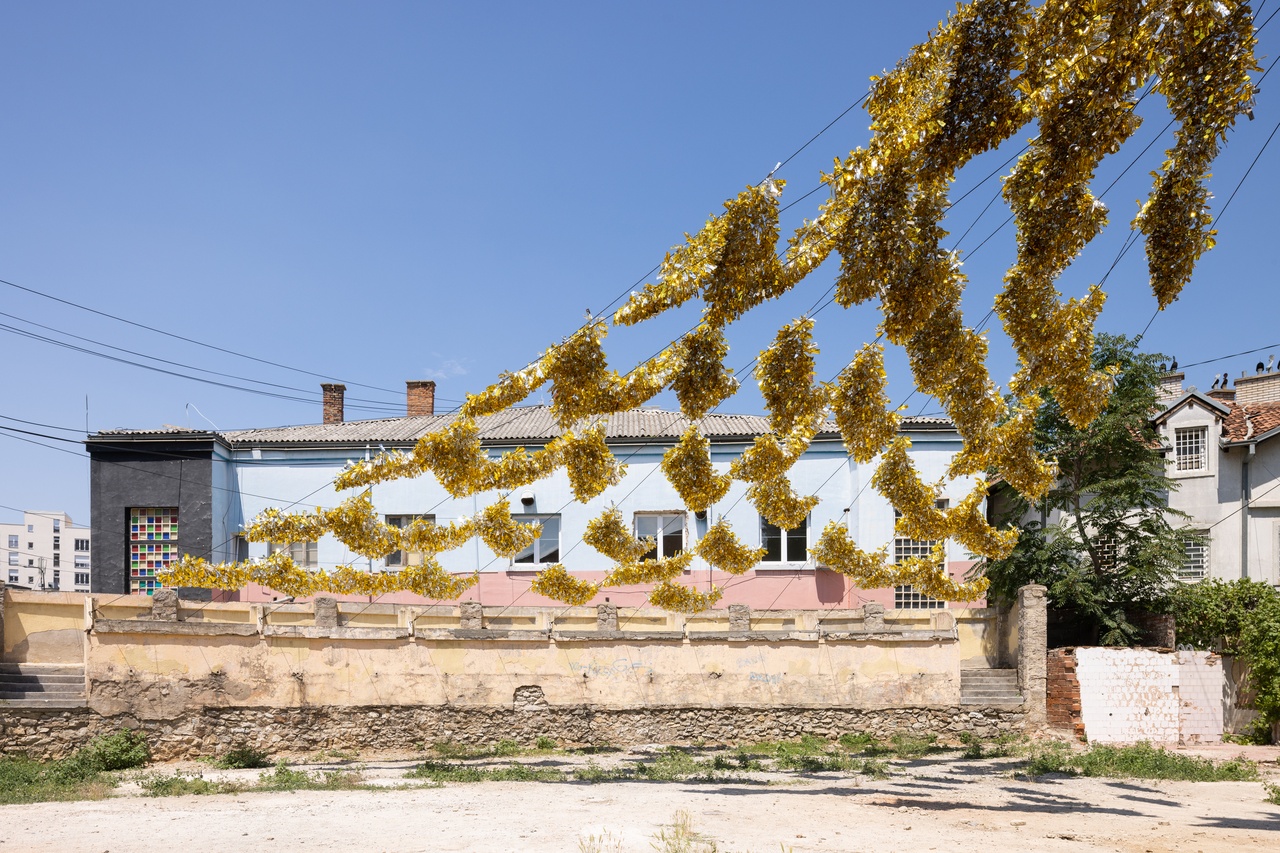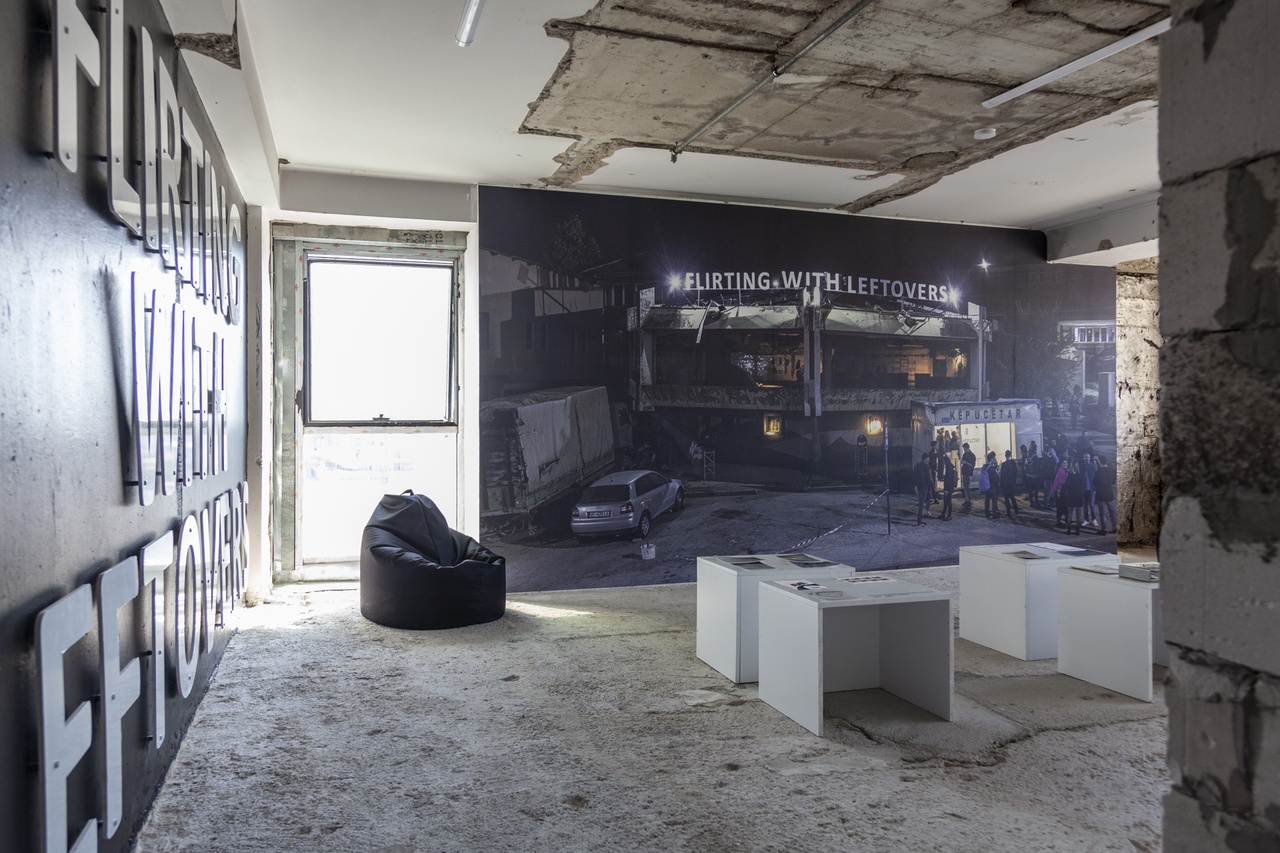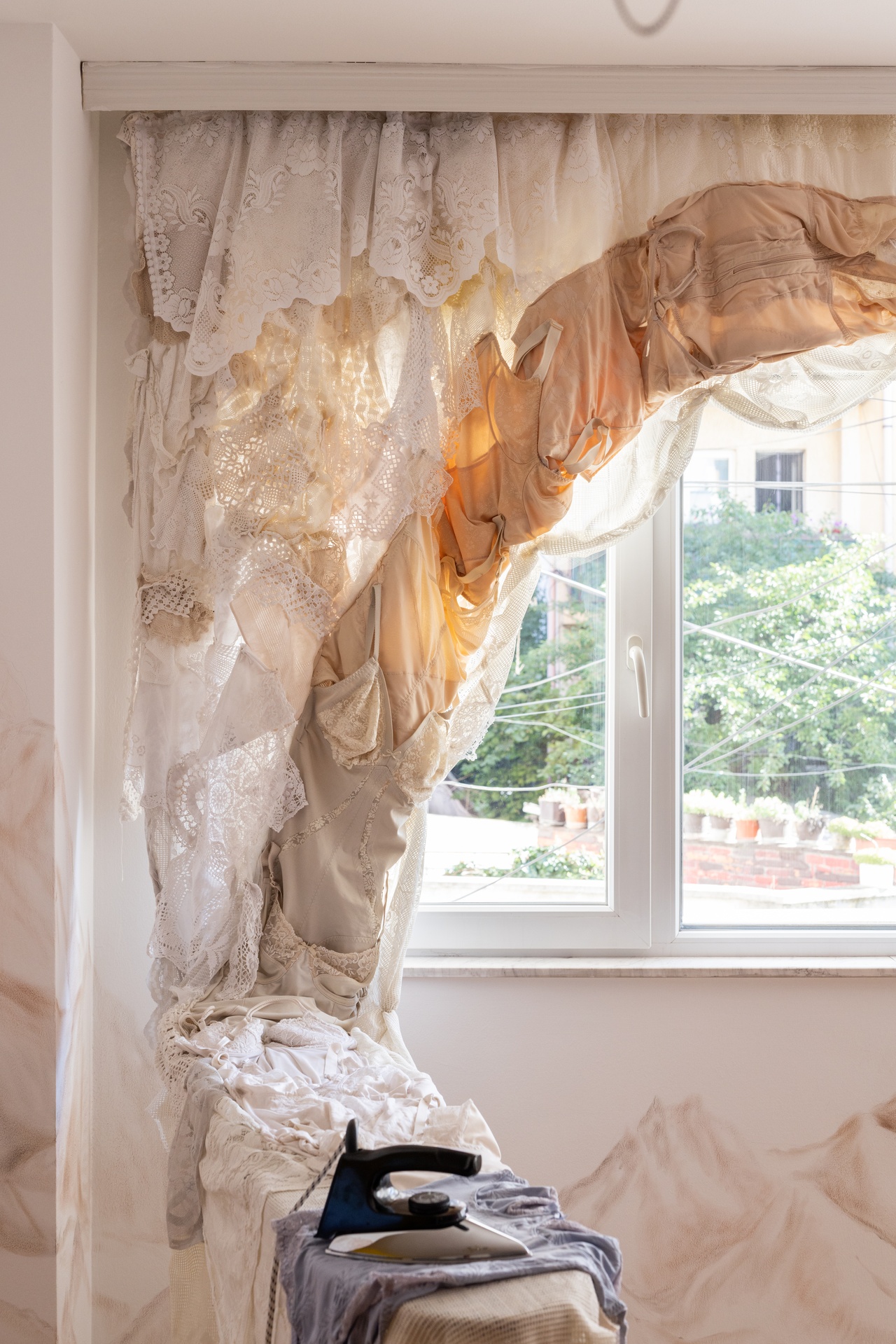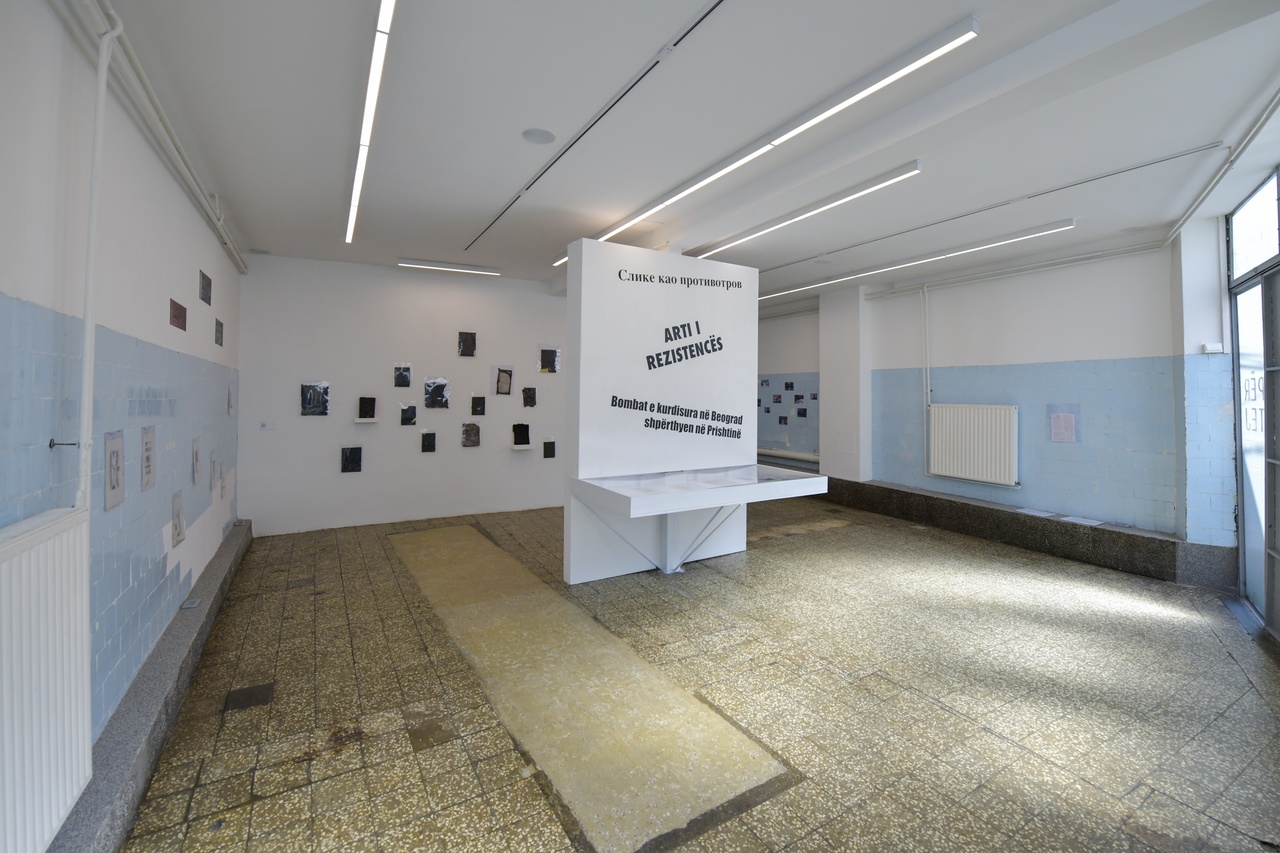BEYOND ACCELERATED PRESENCE Karolina Majewska-Güde on Manifesta 14 in Prishtina

tamtam, “Golden_Soundtrack,” 2022
Prishtina, the capital of Kosovo, doesn’t need the infrastructure of Manifesta to appear interesting to the outsider. As a site of histories in conflict, failed socialist projects, turbo-capitalism, and an isolated contemporary culture, as well as a self-awareness of the potential of all of this, it offers visitors a generous lesson on “staying with the trouble.” [1] The title of Manifesta 14’s artistic program, “it matters what worlds world worlds: how to tell stories otherwise,” borrowed from Donna Haraway, promises new materialist storytellings. Under Creative Mediator Catherine Nichols’s curatorial direction, the biennial unfolds multiple narratives from Prishtina: stories of continuous transformations, diaspora, fragility, longing, collective utopia, hope, and ecological society to come – stories about a “negative space that is always fertile.” [2] But why tell stories like that “when there are only more and more openings and no bottom lines?” [3] Because, as Haraway suggests, they strengthen our “response-abilities” to the world in which we find ourselves. [4]
The exhibition occupies representative buildings created during the Austro-Habsburg and Ottoman empires, the spectacular cultural infrastructure of Jugoslav modernism, and post-industrial and public spaces. The main locations are the Grand Hotel Prishtina, with its thematic exhibition “The Grand Scheme of Things,” and places for discursive programs as well as research: the post-industrial Brick Factory, and the Centre for Narrative Practice, hosting the Oaza educational space. The other 23 venues include Kosovar cultural institutions, artist-run spaces, and public and private buildings of various functions. Manifesta gently guides its international visitors through the city’s urban fabric. Artistic interventions allow us to shape fragmented knowledge into narratives about the conflicts, current expectations, and clichés about “Europe’s youngest country.” For regional audiences, it is supposed to work differently. A program of workshops aims to turn local communities and cultural actors into storytellers by working with the discontinuities of their own history. Who owns the city? Who owns the country? And who should?

Koja, “Flirting with Leftovers,” 2022
To envision potential futures and lessons from and for Prishtina, site-specific data was collected and analyzed by Carlo Ratti Associati (CRA), international experts on participative urbanism. The results of its research project Urban Vision have been used to develop Manifesta’s structure. Ratti was appointed as a second Creative Mediator of the biennial to devise localized solutions on how to reclaim public space in a rapidly changing city. The research resulted in modest urban interventions such as the Green Corridor, a tree-lined pedestrian walkway connecting Manifesta sites. It also determined the choice of the show’s main venues: sites of collective memory are used as starting points for the stories told by artists, thereby giving these places of past political and cultural projects a second chance as shared spaces. These politics of site selection can be described as “flirting with leftovers,” [5] in reference to the title of transdisciplinary research by the Kosovar artist Koja (Fitore Isufi Shukriu). Koja’s work, an installation comprising archival material, publications, and mural photographs presented in the main exhibition in the Grand Hotel Prishtina, delves into the history of a derelict brutalist building and attempts to design its potential future. Several other commissioned site-specific interventions follow this line. This strategy is well represented by the Berlin-based tamtam collective (Sam Auinger and Hannes Strobl) in their work Golden_Soundtrack (2022), located in the outdoor space of Kino Rinia, the oldest cinema building in Prishtina. An installation of metallic sail form made from ribbons of cut-up space blankets together with the acoustics of their rustling amid the architecture of the open-air cinema, acts like a musical instrument. Other artists propose a more interventionist relationship to a site. In her project Sister Flats (2022), Alicja Rogalska converted a private apartment into a collective meeting place that offers free legal advice for women, including trans women, in Prishtina. A video documentary shown in the space deals with the gendered structure of Kosovar society, especially in relation to economic violence. The project, realized in cooperation with local feminist groups, intends to share knowledge and resources to support Kosovar activists in their work.

Alicja Rogalska, “Sister Flats” (detail), 2022
Some of the curatorial site selection decisions were driven by a search for lasting impact, as in the case of the formerly abandoned Hivzi Sylejmani library being repurposed as the Centre for Narrative Practices, which hosts the biennial’s public program and which will remain open as the city’s new cultural hub. Thinking about sustainability was also central for the Brick Factory interventions. This post-industrial site became a resource for the project [Working on] Common Ground, “a 100-day laboratory for eco-urban learning and making” [6] by the Berlin-based studio raumlabor in collaboration with the local community and collectives. This project best expresses curator Nichols’s intention to tell stories “otherwise.” The factory is not only a setting but also a research object for urban ecological thinking on an energy-positive future and soft democracy. [Working on] Common Ground directly tackles what is at stake in Prishtina – not as an art safari but rather as field research. An imaginary non-human narrator of The Diary of the Smokeless Chimney That Saw It All (2022) expresses some doubts about the possible lasting effects of Manifesta. The diary, placed in one of the factory’s derelict furnaces and developed by the collective SØURCERS, concludes, however, on the positive utopian note that in the future, the Brick Factory will be “the first energy positive collaborative and become a model for future collaboratives.”
The main exhibition, “The Grand Scheme of Things,” also tells a story that progresses from matters of concern to utopianism and is collectively narrated by subjects that rage from migrant workers to underwater mermaid cyborgs. Arranged around themes of transition, migration, water, capital, love, ecology, and speculation, each occupying one floor, it provides an opportunity to see art in the context of Prishtina’s urban landscape. The large windows of Hotel Prishtina give a glimpse of the pioneering architecture in its neighborhood. For example, an installation of drawings on brown kraft paper with childlike aesthetics by Artan Hajrullahu is shown against the vast panorama and make us feel connected to the area’s inhabitants. This form of coexistence is reinforced by the functionality of the building. The former 5-star hotel for Yugoslav party officials, privatized since 2006, is now run as a low-standard hotel. Guests mingle with art visitors, creating a hybrid audience with different rhythms.
Intimate, local, regional, and global narratives intertwine in the exhibition. In its section on capital, there is room not only for stories on global extractivism but also for highly local stories, such as the history of Agricultural Cooperative Krusha, founded in 2005 by Fahrije Hoti after her husband and other men and young boys from her village were killed during the war in Kosovo. The collective labor of the all-women co-op is exhibited in the form of food products alongside art projects.

“PËRTEJ–Archiving Transition,” Manifesta 14, 2022, installation view
While the exhibition confronts its viewers with stories of repair and maintenance, the public programming also focuses on sharing practical knowledge by offering writing, publishing, and archiving workshops. Archives are crucial for self-historicization, which is why several projects engage with them. Transformation Archive (2022) at the non-profit Galeria 17, a space run by Foundation 17 talks about the political complexities of exhibition making in a regional context. It is a show that recreates the then-controversial “PËRTEJ” (English: Beyond) exhibition of Albanian artists from Kosovo at Belgrade’s Center for Cultural Decontamination in 1997. This project, included in the biennial as a form of institutional critique, draws our attention to the question: What are the actual exhibition politics of Manifesta 14? The show forces us to look beyond the organizers’ declarations and our own reactions to the art and to see the European Nomadic Biennial in Prishtina in a broader political and historical framework.
Manifesta makes it easy for the international public to navigate the art scene of a city whose artists and other cultural workers cannot freely travel due to the strict visa regulations of the EU. Manifesta, organized “to empower local actors and communities in the fields of culture, civil society, education, architecture, research and cultural policy,” [7] puts the category of “Kosovar artists” on the map. The aim of the Kosovar politicians and cultural workers is to work toward consolidating the initiated networks, institutions, and commitments, a process that is known in the region under the familiar term “development.” The idea of mutual gains has to be seen not only in light of the political and ideological agency of Manifesta; one also has to take into account its curatorial vision. Manifesta as an institution aims to achieve sustainable results from its artistic and urban research. Tenderly curated, it wants to advocate for “love, not efficiency” [8] at the same time. And even though the narratives of who owns Prishtina are collectively produced, a form of epistemic injustice is inscribed in the process. While mainly regional artists had their say in this, it does not mitigate the fact that Kosovo was put on display as a laboratory of a future sustainable society that “must be a bit haphazard, broken, lame, twisted, ironic silly, sad. […] A shifting world, a world of love, of philos. The worlds of seduction and repulsion, rather than authority.” [9] As the issues of owning your narrative and having your own agency are crucial for Prishtina and Kosovo, it’s preferable to debate them in front of a critical public on the international stage than to say silent on them.
“Manifesta 14,” Prishtina, Kosovo, July 7–October 30, 2022.
Karolina Majewska-Güde, PhD, is a researcher, art historian, and curator. Her research focuses on the East Central European neo-avant-gardes, feminist epistemologies, performance art, and contemporary issues of circulation, translation, and knowledge-production through art-based research. She is a member of the research collective pisze/mówi/robi, which combines performative and interpretative research on artistic archives. Her recent book Ewa Partum’s Artistic Practice: An Atlas of Continuity in Different Locations was published by Transcript in 2021.
Image credit: © tamtam, photo: Manifesta 14 Prishtina / Ivan Erofeev; 2. © Fitore Isufi Shukriu–Koja, photo: Manifesta 14 Prishtina / Majlinda Hoxha; 3. © Alicja Rogalska, photo: Manifesta 14 Prishtina / Ivan Erofeev; 4. © Foundation 17, photo: Manifesta 14 Prishtina / Majlinda Hoxha
Notes
| [1] | This is in reference to Donna Haraway, Staying with the Trouble: Making Kin in the Chthulucene (Durham, NC Duke University Press: 2016). |
| [2] | A sentence from Driant Zeneli’s film The firefly keeps falling and the snake keeps growing (2022) presented in the section on the theme “speculation” in the exhibition “The Grand Scheme of Things.” |
| [3] | Haraway, Staying with the Trouble, 29. The title of the exhibition is a quotation taken from the same publication. |
| [4] | Ibid. |
| [5] | Koja (Fitore Isufi Shukriu), Flirting with Leftovers (2019), https://manifesta14.org/participant/fitore-isufi-shukriu-koja/. |
| [6] | See the venue page at the Manifesta website: https://manifesta14.org/venue/brick-factory/ |
| [7] | Quoted at: https://manifesta14.org/pre-biennial/expectation-workshops/ |
| [8] | I refer to Timothy Morton, All Art Is Ecological (London: Penguin, 2018), 15. |
| [9] | Morton, All Art Is Ecological, 17. |
